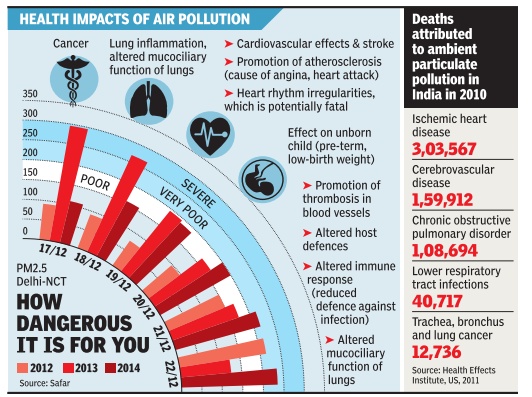Air pollution: Delhi
This is a collection of articles archived for the excellence of their content. |
Contents |
Extent of pollution
See graphic
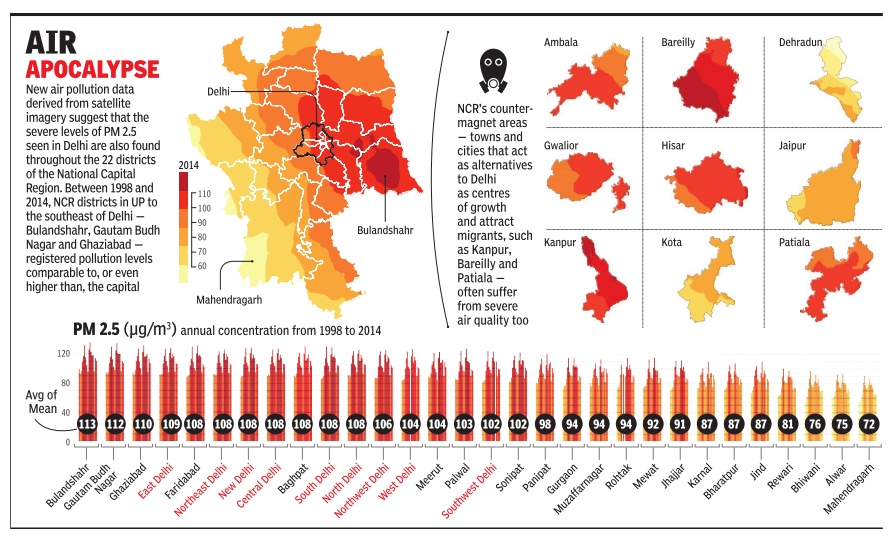
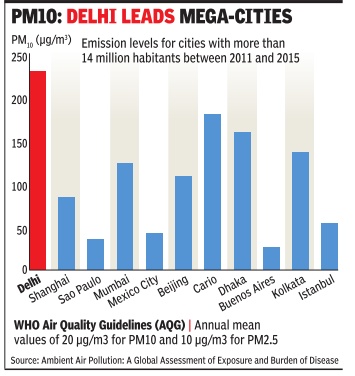
The Times of India
Understanding air pollution in Delhi in steps
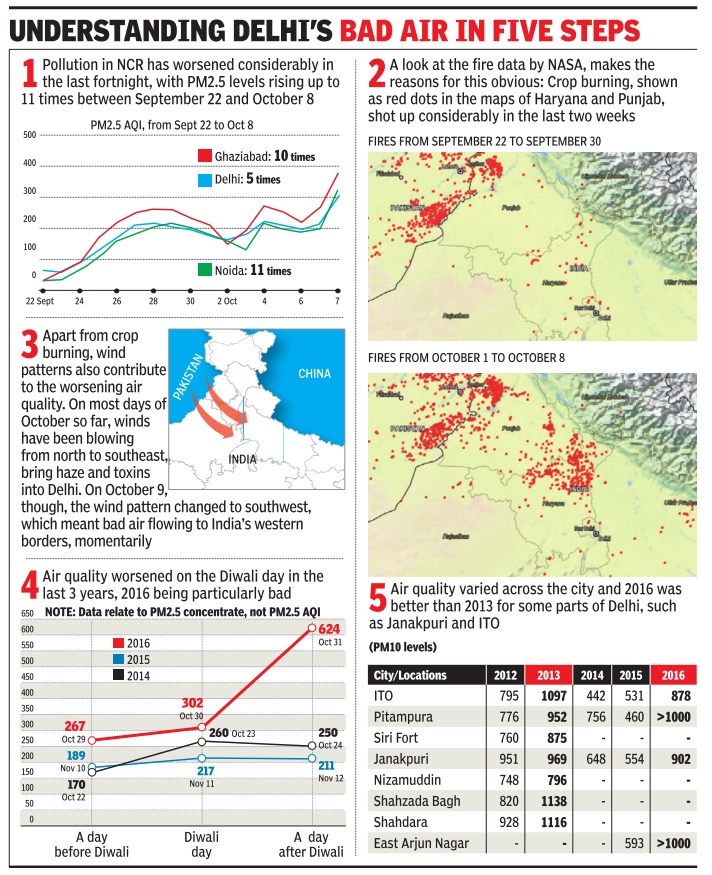
From October 10, 2017: The Times of India
See graphic, Understanding air pollution in Delhi in 5 steps
2014: Ambient Air Pollution (AAP) database
Delhi has the worst air pollution in the world: WHO PTI | May 7, 2014
NEW DELHI: Delhi is the most polluted city in the world when it comes to air quality, according to a WHO study released today.
The 2014 version of the Ambient Air Pollution (AAP) database contains results of outdoor air pollution monitoring from almost 1600 cities in 91 countries.
India's national capital has the highest concentration of PM2.5 — particulate matters less than 2.5 microns— form of air pollution, which is considered most serious.
This form of concentration consists of tiny particles that put people at additional risk of respiratory diseases and other health problems, the World Health Organization said.
The situation is so bad in Delhi that its air has PM2.5 concentrations of 153 micrograms and PM10 concentrations of 286 micrograms — much more than the permissible limits.
In comparison, Beijing, which was once considered one of the most polluted cities, has PM2.5 concentration of 56 micrograms and PM10 concentration of 121 micro grammes.
Air quality is represented by annual mean concentration of fine particulate matter (PM10 and PM2.5, particles smaller than 10 or 2.5 microns).
The database covers the period from 2008 to 2013, with the majority of values for the years 2011 and 2012.
"Many factors contribute to this increase, including reliance on fossil fuels such as coal fired power plants, dependence on private transport motor vehicles, inefficient use of energy in buildings, and the use of biomass for cooking and heating," WHO said.
High levels of oxides of nitrogen (Nox) and particulate matter (PM)

The Times of India, Sep 1, 2011
Air pollution back as big health threat in city
Air pollution has again become a major threat to public health in Delhi, say environmentalists. With 69 lakh vehicles plying on city roads, a growth of about 60 lakh in 20 years, experts say oxides of nitrogen (NOx) and particulate matter (PM) are now at critically high levels.
NOx and PM are known to cause cancer and asthma. Medical experts say signs of deteriorating health are already manifest. The Delhi cancer registry maintained by AIIMS shows a 2-3% rise in lung cancer cases every year.
Dr Vinod Raina, a cancer specialist at AIIMS says till some years ago, 14-15 lung cancer cases were reported for every 1 lakh cancer patients. “Of late, we have been getting about 13,000 new cases of cancer each year, of which 10% come in with lung cancer. And, 30% of lung cancer patients have nothing to do with smoking,” he said.
The Centre for Science and Environment says vehicular pollution has returned as a big threat in Delhi. “About 55% of Delhiites stay within a 500m distance from main roads where vehicular pollution is at an all-time high. After public transport was converted to CNG, pollution has become invisible but is still on the rise,” said Anumita Roychowdhury, associate director, CSE.
“In the 1990s, when the issue of air pollution was first raised, only particulate matter was being monitored. Now there is also a red alert on NOx and PM. AIIMS has been tracking hospital admissions and has found that they have been rising in winter months when pollution levels rise,” Roychowdhury said.
BREATH OF FOUL AIR
Delhi cancer registry at AIIMS shows 2-3% rise in lung cancer cases every year. 30% of these patients don’t smoke 55% of Delhiites stay within 500m from main roads, where vehicular pollution is at all-time high Commuters travelling in AC vehicles suffer 35-55% less pollution as compared to those in autos Environmentalists say levels of NOx and particulate matter in Delhi’s air now a major threat to public health.
AC cars may keep you fit
Air pollution is posing serious health hazards for the people of the national capital.
Researchers from Berkeley University carried out a survey in Delhi between February and May 2010 to analyse the impact of pollution on those using public transport.
The study – Concentration of fine, ultrafine and black carbon particles in autorickshaws in New Delhi, India – published in Atmospheric Environment, says those travelling in autos and cars with windows rolled down are exposed to 1.5 times more PM 2.5 concentrations than the ambient air. Exposure to ultrafine particles are 8.5 times higher. Joshua Apte, who headed the research, said those travelling in air-conditioned vehicles suffered 35-55% less pollution as compared to those in autos.
Air pollution at public places: Delhi
Jayashree Nandi, Dec 11 2014
The air in which one breathes through the day may be far worse than what the government's pollution monitoring. Because we often spend long hours near emission sources--on footpaths, along heavily congested roads, in an auto rickshaw in peak traffic and even in parks during morning walks. To assess what our real exposure may be like, TOI, in association with Centre for Science and Environment (CSE), spent a day monitoring hourly PM 2.5 (fine, respirable particles) on CSE's portable air quality monitoring device in front of schools, hospitals, shopping areas and traffic cop booths.
The idea was to understand what kind of air pollution levels children on their way to schools or patients outside hospitals may be exposed to. The hourly PM 2.5 averages logged at these locations were compared with the ambient air quality monitored by Delhi Pollution Control Committee (DPCC)'s monitoring stations near the locations.
The results were very disturbing -outside Mother's International School on Aurobindo Marg, for instance, the average for 8 am to 9 am was 718 micrograms per cubic metre! While there is no official safe standard for an hourly average, the 24-hour average for PM 2.5 in India is about 60 micrograms per cubic metre. The machine-TSI DustTrak DRX Aerosol Monitor 8533 showed peaks up to 800 micrograms per cubic metre, about 13 times the daily standard. During the same period, DPCC's RK Puram monitoring station recorded an hourly average of just 325 micrograms per cubic metre.
Inside All India Institute of Medical Science (AIIMS) campus, between 9.10 am and 10.10 am, the hourly average was 493 micrograms per cubic metre. Considering that patients with low immunity go to the hospital, they may be exposing themselves to more complications in such conditions.
As it got warmer and sunnier, PM 2.5 concentrations started plunging. At RK Puram, in front of Delhi Public School, the hourly average was 248 micrograms per cubic metre and later at Saket, in front of a shopping mall, the concentration was about 178 micrograms per cubic metre.
The exercise of monitoring exposure levels through the day also revealed the diurnal variation in pollution levels with air quality improving considerably in the afternoon (1 pm to 4 pm), especially if it is sunny and warm. The air quality started declining once again after 4.30 pm. This exercise also revealed that areas with a smooth but less vehicular traffic can have relatively much better air quality . In front of Dr Ram Manohar Lohia Hospital, for instance, traffic flowed smoothly . Here, the PM 2.5 concentrations ranged between 100 and 180 micrograms per cubic metre, far lower than other locations.
Government pollution monitoring agencies have claimed that such exposure monitoring may be “unscientific“ as such devices are mainly meant for “industrial“ projects and that there is no official standard for hourly readings. “Both pieces of information are valuable. The legal standard is indeed based on daily average concentrations measured at a fixed location. As our research demonstrates, air pollution levels in Delhi vary substantially with time and place, depending on where one is. In many locales, like in traffic, particulate matter levels are much higher than what official monitors indicate,“ said Joshua Apte of Lawrence Berkeley National Laboratory , who has done similar research in Delhi.
Delhi: air and noise pollution
See graphic.
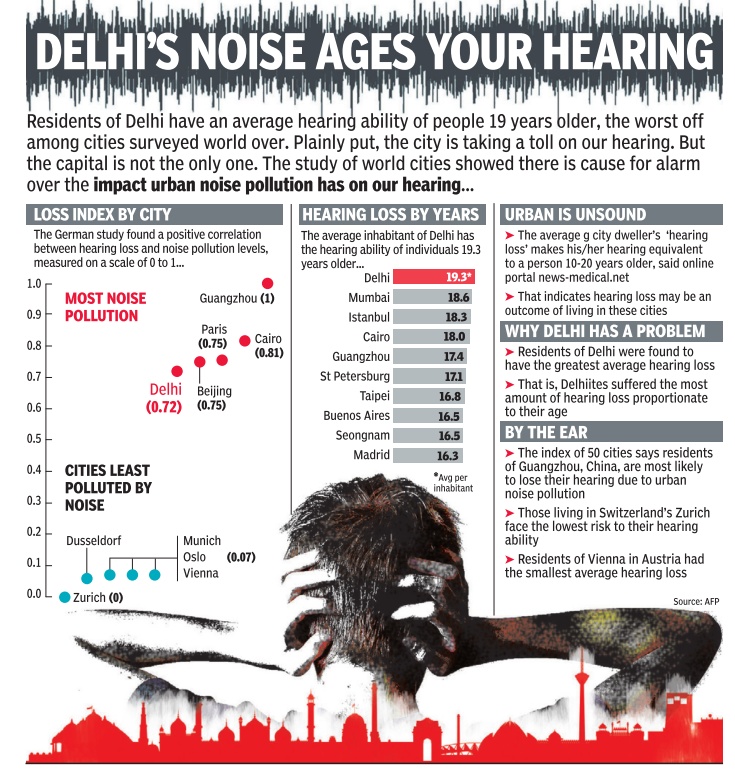
Historical trends: Changes in pollution levels over the years:
2000-2015: University of Miami’s analysis
The Times of India Jan 07 2016
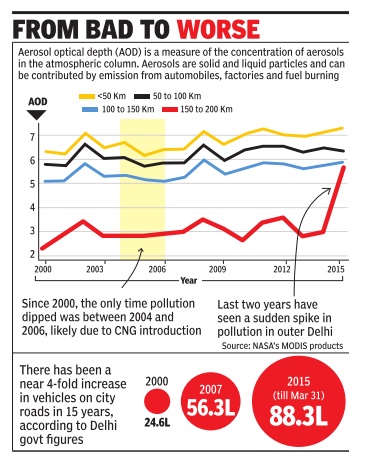
Jayashree Nandi
Air pollution has been increasing in and around Delhi since the year 2000 with just two blips between 2004 and 2006, a new analysis has revealed. This contradicts government agencies' claim that there is no definite trend of deteriorating air quality .
Using satellite measurements, an American scientist has found a steady increase in both PM2.5 (fine, respirable particles) and PM10 (coarse particles) in Delhi's air between 2000 and 2015, with the annual averages ranging from 74 to 92 micrograms per cubic metre.
Naresh Kumar, associate professor of environmental health at the University of Miami, USA, analysed satellitebased aerosol optical depth (AOD) in and around Delhi 2000 onwards, using data from Moderate Resolution Imaging Spectroradiometer (MODIS), on board the NASA satellites Terra and Aqua. AOD measures the concentration of aerosols or solid and liquid particles suspended in air that can arise from human activities, such as driving and construction, or natural factors like dust and water vapour.
His analysis shows the worst air quality in a 50km radius around Connaught Place and the cleanest in a range of 150-200km, showing how urbanization causes pollution.The AOD around Connaught Place ranged from 0.6 to 0.7, whereas in the US it was less than 0.2.
Kumar says industries and burning of garbage and plant matter could also be driving up air pollution, especially in winter when a blanket of cold air makes the dispersion of pollutants difficult. About ve hicles, he says, they are among the main sources of PM2.5 and reactive gases, such as nitrogen oxides and carbon monoxide, and volatile organic compounds. “If the city wants to cope with air pollution, it needs a multi-sectoral approach.“
Kumar is also tracking the impact of the odd-even experiment in Delhi but hasn't drawn any conclusions yet.“Weather plays an important role in dispersion and transport of air pollution. The 1952 London smog was caused by high levels of air pollution and cold air masses.“ But he says halving the number of diesel vehicles on the road will certainly reduce people's local exposure to pollutants.
Kumar is running a map: precise.ccs.miami.edudelhi that shows air pollution data in real-time. Each place, he says, has a more or less fixed capacity to disperse air pollution. “The capacity will remain the same in the future unless artificial filters are installed to check the increasing pollution in the city . The problem is that the pollution from anthropogenic (human) activities has been increasing dramatically without any effective mechanism to clean the air pollution, assuming it will disperse automatically .“
Causes of pollution
Crop fires
See Burning crop stubble: India
Account for 70% of pollution on some days
Crop fires sometimes have 70% share in Delhi’s air pollution Amit Bhattacharya, `Crop fires had 70% share in city's peak air pollution' Contribution, Nov 08 2016 : The Times of India
Up From Zero On Nov 1: Expert
Crop fires in Punjab and Haryana contributed as much as 70% of the pollution load in Delhi on Sunday , [6 Nov] the city's worst air day in a long time, a leading government scientist said, basing his assessment on computer models used to determine the capital's air quality index.
Gufran Beig, program di rector of Safar (System of Air Quality and Weather Forecasting and Research), under the earth sciences ministry, said on Monday that the proportion of pollutants from crop fires in Delhi's air rose dramatically from almost zero on November 1 to a peak of 70% on November 6.
“Safar's chemistry transport model gives a clear picture of the share of pollution from external sources. It shows pollution load from crop fires in Punjab and Haryana rose steadily after November 1 due to favourable upper air winds,“ Beig said.
The smog cleared significantly on Monday , helped by a pick-up in surface winds and a change in upper-air direction. “The share of cropburning in Delhi's air quality was down to 50% and dropping,“ the scientist said. Like a perfect storm, various factors fell in place to create the dense smog spell over NCR, which SAFAR programme director Gufran Beig described as an “extreme pollution event“.“While the surface air was calm over the capital, upper air wind direction changed around November 1, when winds blew in from between west and north, directly transporting pollutants from crop fires,“ the scientist said.
The calm surface winds and an air ridge over NCR prevented the pollutants from dispersing, leading to an accumulation of toxic chemicals in the air.
Beig said the PM 2.5 concentrations in Delhi's air were at unprecedented levels on Sunday .
“Since we started SAFAR five years ago, we have never seen the value of PM 2.5 concentrations crossing 700µg m3. Just as extreme weather events are increasing so are extreme pollution events such as this one,“ he said.
SAFAR's figures on contribution of biomass burning in Delhi's air pollution come on a day when Union environment minister Anil Madhav Dave said crop burn ing was responsible for just 20% of the pollution level in the national capital.
That figure is based on source apportionment studies that have variously put the external contribution to winter pollution in Delhi at 20% to 35%. Beig said these studies give an average which would hold true in general terms but can't be used for specific events.
“This is like telling you what the normal rainfall at a place is. SAFAR's figures, on the other hand, are based on the actual conditions that existed during this period,“ the expert said.
Due to surface winds picking up, Beig predicted that the pollution levels would drop on Tuesday , while still staying in “severe“ zone, and come down further to “very poor“ levels on Wednesday .
Industrial pollution
The Times of India, December 20, 2016

Jayashree Nandi Industry's top choice of fuel cheap but deadly
EPCA's Plea In SC To Ban Use Of Furnace Oil Brings Threat To Air In Focus
The national capital region (NCR) may be one of the most polluted regions in the country but many industries located are still running on an extremely polluting fuel -furnace oil.
A substantially cheaper alternative to natural gas and diesel, FO, as it is called in industrial terminology , is marginally better than bitumen in quality .It emits substantially higher particulate matter (PM) and secondary sulphate particles, said scientists.
The widespread use of FO came to light only recently after the Supreme Court-mandated Environment Pollution Control Authority (EPCA) investigated its use in NCR and submitted a report to SC. The report also highlighted the use of pet coke, another high sulphur fuel, in NCR.
Industries in Ghaziabad's Sahibabad and Loni Road industrial areas admit that they use FO despite knowing how harmful it is for environment.A large steel company TOI visited in Sahibabad, for instance, runs its generator on FO and natural gas.
“It's a 30:70 ratio, with FO making 70% of the fuel. It's cheap and serves the purpose. I don't think the Supreme Court can ban it because industries are a powerful lobby . Also, what will oil refineries do with the FO they generate?“ said its head of purchase. FO is priced around Rs 25 per litre, compared to Rs 56.76 for diesel, Rs 69.3 for petrol and Rs 24.5 per standard cubic meter for piped natural gas.
About three months ago, the price of FO fell to Rs 15 per litre due to the dip in crude oil prices. “The prices fell seven times in the past year or so. It just makes economic sense for industries to opt for a cheaper fuel. Of course, it's way more polluting and you can tell from the chimney smoke whether a factory is using FO. It's usually black or blue smoke. That's why we invested in piped gas supply ,“ said a senior representative from another steel company's hot rolling and heat treatment division.
TOI also found several dyeing, paper recycling and glass industries using FO.
A representative from Indo Petro, a dealer, said, “Many industries in Delhi too use it illegally because it's cheaper.“
Anant Bhargav, director of IFP Petro Products, said, “The government can have Bharat Standard (BS)-type norms for industrial fuel. Some industries even use very toxic tyre oil made from used rubber and ty res. Major dealers supply these fuels.“
Around 30 forging industries use FO in Ghaziabad, added an Industrial Area Manufacturer's Association member.
Mukesh Sharma, scientist at IIT Kanpur and author of Comprehensive Study on Air Pollution and Green House Gases (GHGs) in Delhi -the latest source apportionment study , said, “The PM emissions from FO are substantially higher than other liquid or gaseous fuels. Since the sulphur content in FO and pet coke is high, a large amount of sulphur dioxide (SO2) is released that converts into fine sulphate particles in the atmosphere.“
The sulphur content in FO is 15,000 to 20,000 ppm and about 70,000 ppm in pet coke compared to around 50 ppm in diesel. Scientists recommend that high sulphur fuel should only be used in cement industries because the calcium oxides generated in these factories can neutralise the sulphur emission.
During a recent hearing in SC, a lawyer representing the Centre sought time to respond to EPCA 's submission. The apex court has given the Centre four weeks to examine whether pet coke and FO, if used as industrial fuel, is harmful.
“In case the government comes to the conclusion that its use is indeed harmful, it may consider issuing appropriate directions in terms of Section 3(2)(v) of the Air Act,“ the order said.
According to EPCA 's report, a big manufacturer of solar panels, a glass company and steel companies are using FO. Apart from PSUs, a private company also supplies FO.
Diesel use and air pollution on a rise in Delhi
Air pollution and Diesel use rising fast in Delhi
December 17, 2014
Consumption of diesel in Delhi has been increasing steadily since 2010 while that of petrol is declining. Simultaneously, air pollution--especially the concentrations of PM 2.5 (fine, respirable particles) and PM 10 (coarse pollution particles) --is on the rise. Diesel consumption peaked in Delhi in 2007-08 at 13.94 lakh metric tonnes but then declined to 8 lakh tonnes in 2010, possibly due to higher taxes on the fuel. But it has been rising sharply again since 2011. In 2012-13 it stood at 10.29 lakh tonnes and reached 11.29 lakh tonnes in 201314, a 10% increase.
Particulate matter (PM) is associated with diesel emissions. Analysis by Centre for Science and Environment (CSE) shows PM10 levels have increased by about 75% since 2005 with occasional dips.
Anumita Roy Chowdhury of CSE's Clean Air Programme says increasing diesel consumption in Delhi is worrying. “The data only shows massive dieselization in Delhi. Diesel primarily contributes to emissions of particulate matter (PM) and oxides of nitrogen (NOX), which are both increasing.“
She said diesel vehicles emit five times more PM than petrol vehicles. “I think die sel and, if required, diesel vehicles need to be taxed in a way that the increased revenue can be used for refineries to produce clean diesel.Delhi needs 10ppm sulphur fuel by 2020,“ Roy Chowdhury added.
Diesel pricing was de-regulated earlier this year, which means it is now linked to the global market without any government intervention.
The other concern with diesel consumption is its health consequences. World Health Organization has graded diesel emissions as carcinogenic (causing cancer). Roy Chowdhury said that it is in the same category as tobacco.
The consumption of CNG has increased from 5 lakh metric tonnes in 2009 to 6.98 lakh metric tones in 2013-14.Consumption of kerosene has seen a sharp decline over the years from 1.62 lakh metric tonnes in 2006 to 1.07 lakh metric tonnes in 2010 and just 9,000 metric tonnes in 2013-14.
Dust pollutes Delhi more than cars: Government
Dhananjay Mahapatra & Amit Anand Choudhary
The Times of India Jan 08 2015
SC told vehicles contribute just 6.6% and dust's share is 52% : Ministry of Environment and Forest
The major source of pollution in the capital is dust particles and not vehicular emissions, the ministry of environment and forest (MoEF) submitted before Supreme Court.
While dust contributed 52% of particulate matter in the air, pollutions from vehicles, including trucks and light commercial vehicles, accounted for just 6.6%, the ministry said.
“In Delhi, vehicles contribute only 6.6% particulate matter (PM) emission, 18.3% oxides of nitrogen (NOx) and 0.3% of noxious sulphur dioxide (SO2) emissions whereas dust particles from pavedunpaved roads contributed 52% of particulate matter pollution,“ the ministry said, quoting a Source Apportionment Studies conducted in Delhi, Kanpur, Pune, Mumbai, Chennai and Bengaluru.
“The source apportionment study carried out in Delhi reveals that re-suspension of the dust is also the major source of particulates in the ambient air. There is a need to focus on initiation of steps to reduce re-suspension of dust and managementregulation of construction activities,“ MoEF said.
Of the total particulate matter and NOx pollution caused by vehicles, private cars were responsible for 22% while trucks caused 45.8% and light commercial vehicles 27%, it said.
“Industry power plants contribute 78% of NOx and 95.4% of SO2 content in the ambient air,“ the ministry said. It also responded to several suggestions made by se nior advocate Harish Salve, who as amicus curiae had personally filed an application drawing the court's attention to the deteriorating ambient air quality of the capital, which squandered the advantage of converting its entire city passenger transport fleet to cleaner fuel CNG on court's orders more than a decade back.
Clarifying that the National Green Tribunal headed by former SC judge, Swatanter Kumar, was already seized of the issues raised by Salve, the ministry said Salve's suggestion to restrict plying of private cars on alternative days might not be feasible.
“It may not be an effective and feasible option as people using personal cars are not likely to shift the mode of travel. Persons using two-wheelers are likely to shift to public transport, which may lead to excessive pressure on services without yielding much benefit,“ it said and informed the court that it has sought views of public transport providers on this issue.
Salve had also said schoolchildren were the worst sufferers of the deterioration in ambient air quality and suggested closure of schools on `red alert days', when the air quality nosedives. “Exposure of school going children to higher level of pollution occurs only for limited period during travel, while Air Quality Index (AQI) is based on 24hourly average standard and prolonged exposures. Moreover, most schools are closed for winter breaks (when the air quality becomes worse),“ it said.
The ministry of road transport and highways said that “it is high time that the pollution control authorities conduct studies for apportionment of causes of pollution in habitations including Delhi.All increase of pollution is always ascribed to automobiles based on studies done overseas“.
Green activists disagree
The Times of India, Jan 09 2015
Green activists: Govt misled court on Delhi's pollution
Neha Lalchandani
The government's submission before the Supreme Court that the major source of pollution in the capital was dust particles, and not vehicular emissions, was dismissed by environmental activists as ridiculous, with some even questioning the intent behind the environment ministry's stand. The ministry of environment and forest had told the court that dust was responsible for 52.2% of the pollution load in Delhi while vehicles contributed only 6.6%. But a paper by the Indian Institute of Tropical Meteorology , which started maintaining Delhi's air quality data since the Commonwealth Games, says vehicles contributed to 32% of the total particulate matter of size 2.5 micron and less (PM 2.5) in 2010. The figure has since risen to 36%. Other sources, including unpaved roads and construction activity, contributed 28% in 2010, which came down to 26% in 2013. Sources pointed out that the MoEF report talks about PM in general, not drawing a difference between PM 10 and PM 2.5. The latter is universally considered to be the more harmful of the two, and its levels are considered when drawing up policy.
Questioning the intent behind MoEF's submission, the Centre for Science and Environment accused the ministry of trying to scuttle the role of vehicles in Delhi's rising air pollution “at the behest of automobile companies as combating pollution today requires tough measures to restrain cars and encourage public transport“.
The IITM report, titled `Emissions inventory of anthropogenic PM2.5 and PM10 in Delhi during Commonwealth Games 2010' and authored by Saroj Kumar Sahu, Gufran Beig and Neha S Parkhi says, “The present estimated wind blown dust is more than the total estimation from all other sources and more than four folds in comparison to transport emission. The resuspended dust is associated with the vehicular movement on the road and is directly proportional to the number of ve hicle, its weight and speed as well as the amount of dust on roads.“ It also states that vehicles are the likely cause for even this. “It is likely to be more serious in a city like Delhi due to more vehicles...H ence the transport sector which has direct contribution through fossil fuel combustion and indirect related to road condition provide the key to better air quality in NCRD if properly mitigated.“
Anumita Roychowdhury , who heads CSE's clean air campaign, said, “MoEF has only cited the PM10 inventory , which is the coarse particles.Their limited study , which looked at PM 2.5 levels, was withdrawn by NEERI as it was based on a flawed methodology and ended up blaming cooking LPG for 61% of PM2.5 in Delhi.
Even after stating the government has implemented the SC order on relocation of polluting industries, the re port claims that industry and power plants are still responsible for 78% of nitrogen oxides and 95.4% of sulphur dioxide in the capital. Point is, even dust becomes the carrier for emissions.“
A study carried out by CSE has found that on national holidays when traffic volume is less, pollution is lower.“For instance, on Republic day of 2013, PM2.5 levels in RK Puram declined compared to the previous day from 244 microgramme per cum to 153 microgramme per cum and again rose to 178 microgramme per cum on January 27 and to 345 microgramme per cum by January 28. Similar trends were observed elsewhere,“ said Roychowdhury .
Vehicles from neighbouring areas add to Delhi pollution: CSE, 2016
The Times of India, June 4, 2016
Delhi has the distinction of having the highest vehicular population among the metros. However, the actual daily number of the roads is much higher than the figure of 88 lakh that is toted out as the number of cars in the capital.This is because there is a massive daily influx of passenger and commercial vehicles from other parts of the National Capital Region.
In fact, a new Centre for Science and Environment (CSE) survey has found that the number of vehicles entering Delhi daily is almost as many as those that are registered in the city every year. The video recorded survey showed an average of 3.7 lakh cars and 1.27 two-wheelers entering the city every day . If all 124 entry points to the capital were considered, the number could be as high as 5.65 lakh. CSE recalled that the Economic Survey of Delhi for 2014-15 had found 5.69 lakh vehicles were registe red in Delhi that year, of which cars and SUVs accounted for 1.65 lakh vehicles.
The study was conducted in June 2015 through 24-hour video recording of all categories of vehicles entering and exiting Delhi at nine entry points. These included Kundli border on NH1; Tikri border on NH10; Rajokri on NH8; Badarpur on NH2; Kalindi Kunj; two points at Ghazipur border on NH24; and two points at Shahdara border on NH-19.
The survey , released to mark the World Environment Day on June 5, said that the effort to reduce the number of trucks entering the city by imposing an environmental compensation charge seemed to have been negated by the large number of passenger vehicles coming to Delhi.
“Delhi's battle against pollution, congestion and energy guzzling can get more difficult if its own explosive motorisation gets further aggravated by the huge daily influx of vehicles from outside,“ said Anu mita Roychowdhury , executive director, CSE. “This new analysis reconfirms that ineffective public policy on public transport connectivity is increasing dependence on personal vehicles, leading to enormous pollution and ill-health in Delhi-NCR.“
She also pointed out that an equal number of vehicles went out of Delhi daily, contributing to pollution in the NCR towns as well.
Researchers found that of the approximately four lakh cars entering the city , 55% were cars, 11% SUVs and 27% were two-wheelers. The number of two-wheeler entering the city -around 1.65 lakh from all entry points -is 43% of all new two-wheelers registered in 2014-15.
CSE highlighted the fact that cars driving into Delhi had the highest per capita CO2 emissions at nearly 3,031 gramskm, followed by SUVs at 1,919 gmkm. The buses crossing the border had the smallest CO2 footprint at 539 gm km. “ Against this trend, how will Delhi-NCR participate in India's commitment of an intended national determined contribution of reducing energy intensity by 35% by 2030?“ wondered the green body .
The survey also found that the total number of diesel cars, taxis and SUVs entering Delhi are 2.5 times the total registration of diesel vehicles in the city in 2014-15. “Among all the fuels used in Delhi, diesel still remains the highest. To that is added the daily influx of diesel vehicles that are higher than the local fleet,“ CSE said in its statement.
Now wonder, the organisation said, lung cancer incidence in the city has increased by over 33.3 % since the middle of the last decade. It warned that growing motorisation and dieselisation were continuously adding to the toxic risk in Delhi where the National Cancer Registry Programme showed the highest increase in lung cancer risk among all metro cities.
Diwali air pollution
See graphics
Variations according to season, time
'Air quality: worst at night and early morning
Delhiites may be exposed to the worst air pollution at night and early morning, indicates a study by the Centre for Science and Environment (CSE). CSE chose eight people and monitored their exposure to pollution for 24 hours using a portable device. It also found that situation in the Lutyens' zone, where the rich and the powerful reside, is no better despite the greenery and sparse traffic. The study found PM 2.5 (fine, respirable particulate) levels to be the highest at night and during hours when these people go for morning walk. In some cases, even indoor air quality was extremely poor.
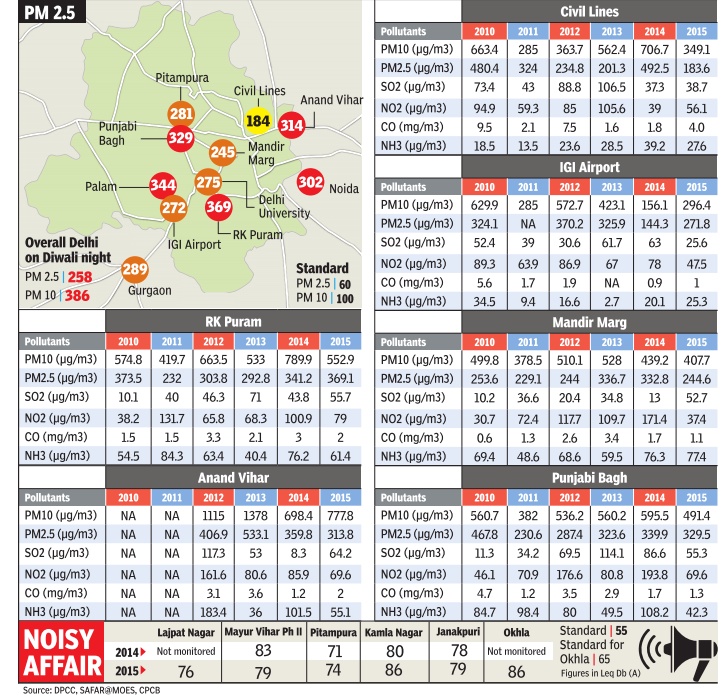
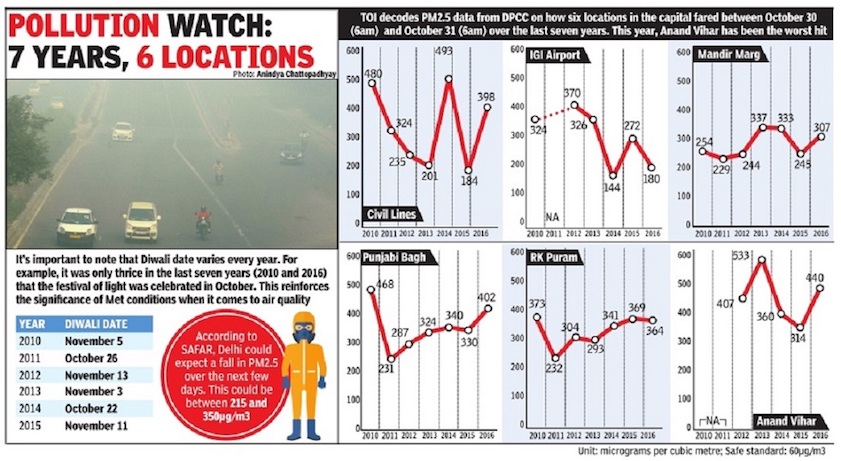
The Times of India
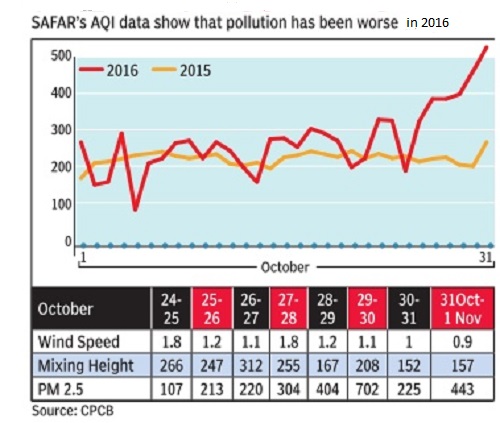
The Times of India
The study involved monitoring the personal exposure of Bhure Lal, chairperson, Environment Pollution (Prevention and Control) Authority (EPCA), a resident of Lodhi Estate, Harish Salve, senior Supreme Court advocate who lives in Vasant Vihar, Ashok B Lall, architect and resident of Civil Lines, Randeep Guleria, head of pulmonary medicine department at AIIMS, William Bissel, head of Fabindia and resident of Hauz Khas enclave.The group also had people who suffer from asthma--Bharati Chaturvedi who lives in Ravindra Nagar in central Delhi, head of Chintan, Kaushik Das Gupta, a journalist and Avikal Somvanshi, a research professional and cyclist.
The 24-hour average exposure of each individual was compared with the readings of the nearest monitoring station of the Delhi Pollution Control Committee (DPCC) which revealed that the real exposure levels were much higher than the official figures. Lal who lives in Lodhi Estate was monitored on November 12 to 13.
Asthmatics are already facing a tough winter. “I was having breathing problems.Doctors recently told me I am borderline asthmatic and may get better if I am in a city with lower pollution levels,“ he said. Sunita Narain, director general of CSE, said she had stopped going for morning walks.
“Our data shows that for a couple of years after introducing CNG the pollution levels had stabilized, but they started to rise steeply with the increase in the number of vehicles. Our soft options are over, we need tough measures now,” Narain said.
Delhi: December: Air Pollution
Respiratory Problems
December 20, 2014 Jayashree Nandi
Air quality in the city deteriorated to “hazardous” levels with the US embassy’s pollution monitoring station advising people to “avoid all physical activity outdoors”. Even the Delhi Pollution Control Committee (DPCC)’s real-time air quality monitoring system showed the 24-hour average count to be over 315 micrograms per cubic metre on Mandir Marg alone, which is about five times the national safe standard. Besides, a layer of smog shrouded the city.
What is worse, there are more such bleak days ahead.
According to System of Air Quality Weather Forecasting and Research (SAFAR) under the ministry of earth sciences, pollution will increase at an alarming level in the next few days with a daily average of over 200 micrograms per cubic metre. The low temperature and calm air are causing “inversion“ that can lead to pollution such as smog being trapped close to the ground. Such poor air quality may trigger respiratory problems among people with low immunity, the elderly and the very young. Doctors fear poor air quality may be doing more damage than just triggering a few wheezing episodes. Constant exposure to bad air is making Delhiites vulnerable to arrhythmias and ischaemic heart disease. Arrhythmia is a disorder characterized by irregular heart beat or abnor mal heart rhythm while ischaemic heart disease is associated with reduced blood supply to the heart.
Dr S K Chhabra, head of cardiorespiratory physiology department of VB Patel Chest Institute, says continuous exposure to high air pollution levels is like being exposed to second-hand smoke. Recently, he made a detailed presentation on this before pollution control agency officials from Saarc countries. Chhabra quoted an AIIMS study which found higher number of complaints and instances of hospitalization due to chronic obstructive pulmonary disorder (COPD) and coronary issues apart from asthma and other respiratory conditions during high pollution days. He also said exposure to diesel emissions causes allergic responses.
“Fine particulate matter and gaseous pollutants are significant risk factors for acute stroke death. Women and the elderly are most susceptible,” his presentation said.
Dr Ashwani Mehta, senior consultant cardiologist at Sir Ganga Ram Hospital also be lieves the rise in incidence of strokes and arrhythmias are linked to high air pollution levels. “The respiratory problems from bad air can affect the heart. Besides, air pollution can cause myocardial infarction or heart attacks. Unfortunately we don’t have much data in India that can directly relate air pollution with the incidence of heart attacks. But increasingly we are seeing young people having heart attacks. Women who you don’t expect to usually suffer heart attacks are increasingly reporting heart attacks. It’s a combination of issues but I think particulate matter is also to blame.” Oncologists are seeing a 1% to 2% rise in lung cancer incidence each year but again there is no documentation of how much of lung cancer incidence is linked to air pollution.
Dr Vinod Raina, director and HOD, oncology and haematology at Fortis Hospital, said there was a “slight increase in incidence of cancer among non-smokers. Otherwise, we need documentation to understand how much air pollution contributes to lung cancer.”
Odd-Even scheme

Phase I: 2016
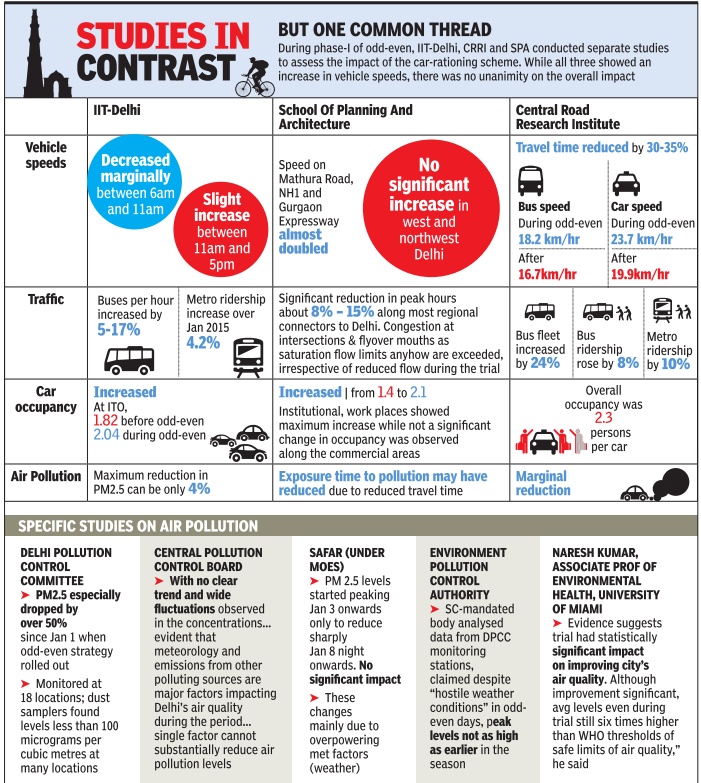

Impact on traffic
The Times of India, April 7, 2016


Odd-even was of little use, says IIT study
A study by IIT Delhi reveals that vehicle speeds had increased 11am onwards during the first phase of the odd-even scheme. The maximum increase recorded was 9%. However, the average speed of vehicles reduced marginally between 6am and 11am at some locations when the road-rationing exercise was undertaken from January 1and 15. The study , “Evaluation of the effects of the 15-day oddeven scheme in Delhi: A preliminary report“, by researchers at Transportation Research and Injury Prevention Programme (TRIPP), IIT-D, also found a high compliance with the odd-even rule at four locations that were observed.
This apart, car-flow rates per hour on different roads decreased by 7-9%. There was almost a similar increase in the number of buses and autorickshaws and a significant rise in the number of two-wheelers during the fortnight, the study says. The air pollution benefits were not apparent because of meteorological factors and the authors of the study felt that data from six stations under the Delhi Pollution Control Committee (DPCC) was not enough to analyse the benefits of the intervention.
According to the study , car occupancy increased at all locations except one. The speed data was extracted by the team using google maps distance matrix API. It provides real-time travel distance and time between a pair of locations.
Despite an overall increase in the speed of vehicles during the period, Dinesh Mohan, a former IIT professor and the lead author of the study, suggested there were no reasons why the scheme should be continued. “Since there is no improvement in air pollution and the impact on congestion is so little and in fact, it al so increased at times, there is no reason to continue it other than gaining international publicity ,“ he said.
He added that motorcycle use had gone up during the odd-even period, which could lead to fatal accidents. On why the vehicle speeds had reduced in the morning hours, Mohan said people might have started early to avoid the rule that came into force from 8am onwards. The lower speeds co uld also be linked to higher number of buses, autos and two-wheelers, Mohan said.
A recent study by School of Planning and Architecture (SPA) found that the vehicle speeds at most locations had increased from 15 to 26kmph.It further said that the improvement in speed was higher during the non-peak hours and that morning peak traffic volume reduced by 8-16%. It had indicated that people's ex posure to air pollution had reduced during the period.
But the IIT study said that “it is possible that the decrease in emissions from cars may be offset by an increase in flow of other vehicles,“ adding that combined PM 2.5 emissions from buses, autos and two-wheelers was estimated to be 20% of the entire the transport sector compared to cars that alone contribute 16% of emissions. While studies by SPA and Central Road Research Institute (CRRI) as well as an evaluation by the SC-appointed Environment Pollution Control Authority (EPCA) have found reduced congestion and pollution exposure during the oddeven scheme, Mohan said such studies needed “technical, rigorous analysis“ and his team had “videographed everything“ because it's very easy to get cheated otherwise.
Phase II: 2016
Impact on traffic
The Times of India, May 13 2016
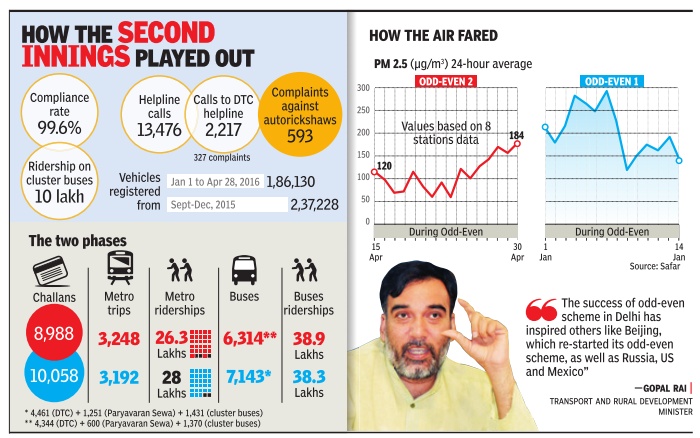
Rumu Banerjee
After the Delhi government's own report claimed that the second phase of the odd-even was successful, but marred due to schools being open, a report by the Central Road Research Institute (CRRI) suggests that even the impact on traffic was minuscle.
The report, which is based on a study carried out by the CRRI under Dr Staish Chandra, the director, during the odd-even fortnight, found a stark difference between the impact of the first odd-even fortnight and the second one, in April.
The study , which was conducted to measure the impact of the odd-even policy on traffic volume and speed characteristics on the road network, mapped two arterial roads of the city--Inner and Outer Ring Road--and compared the impact of the two phases.
Dr Kayitha Ravinder of CRRI said, “There is a significant difference in the impact on traffic volume and speed le vels of the two odd-even pha ses. While the scheme in Ja nuary had huge impact on the speed--it went up by 47% --the scheme in April saw the speed reduced to 23% on the Inner Ring Road and 14% on the Outer Ring Road.“ The le vels are measured against the traffic volume and speed cha racteristics of normal days.
It's not just speed levels which didn't show a signifi cant change. According to the study , which was carried out on April 28 and 29, the impact was felt on the traffic volume as well. “In phase II, the total traffic reduction was only around 10-12%. The reduction in car traffic was only 15%,“ said Dr Ravinder, who conducted the study . In contrast, the traffic volume reduced to 20% during the first phase, with the percentage of cars on road reduced to 30%. “This measure may give results in the short run but not in the long run,“ he added.
Pitfalls: NCR can't handle odd- even
Odd-even may choke mobility in NCR, Jan 20, 2017: The Times of India
Gurgaon, Noida and Gha ziabad will all have to implement the odd-even formula for private vehicles whenever it's rolled out next after the Supreme Court-appointed Environment Pollution Control Authority (EPCA) notified a graded response action plan for a pan-NCR implementation.
Odd-even will kick in if PM2.5 level crosses the “severe“ mark of 300 micrograms per cubic metre (gm3) or PM10 level crosses 500gm3, and persists for 48 hours.
The two previous instances of such a scheme being implemented were both by the Delhi government in 2016, with mixed results.
Neither the Haryana State Pollution Control Board (HSPCB) nor residents feel implementing an odd-even scheme in the city is a good idea. HSPCB officials have expressed that other measures, such as phasing out of diesel autos, could be more significant. “Phasing out of diesel autos or their regular monitoring would be more beneficial, as these are the primary source of air pollution in the city,“ said a HSPCB official.
Residents too seemed unsu re about the scheme's implementation. “Odd-even in Delhi made many people switch to car-pools or other means of transport. But I don't think it's possible in Gurgaon as the city has no public transport,“ said Sector 55 resident Satyendra Bajaj, who travels from his office in Cyber City to Sector 55.
His fears are borne out by the numbers. There are over 7 lakhs cars that travel on Gurgaon's roads every day , though only around 3.2 lakh (including 32,772 CNG cars) are registered in the city . To implement odd-even, authorities will have to make extensive arrangements of manpower and enforcement, as well as public transport. If one is to take a half of the 3.2 lakh cars out of the equation, it saddles the public transport system with at least 1.6 lakh extra passengers, if one person per car is factored in. The real number could well be double or more.
Around 1.5 lakh people travel on DMRC's yellow line between Samaypur Badli (Delhi) and Huda City Centre (Gurgaon). This will multiply manifold when the scheme is implemented. And it will have a cascading effect elsewhere. With only 34,000 autos, 500 bike taxis, 400 e-rickshaws and 62 city buses to cater to people who will be without a car on the odd-even days, chaos will spill over from Metro stations to bus and auto stops.
Garima Bhateja, who lives on Sohna Road and drives to her MG Road office, says: “Rapid Metro doesn't even cover 4km. City buses are rarely seen on roads, leaving us with only autos and taxis as options, both of which are costly and prone to over-charging. Thus, oddeven is not possible here.“
IIT studied hourly PM data in 2016, 2015
Jayashree Nandi, Night traffic smoked out odd-even gains, Mar 28, 2017: The Times of India
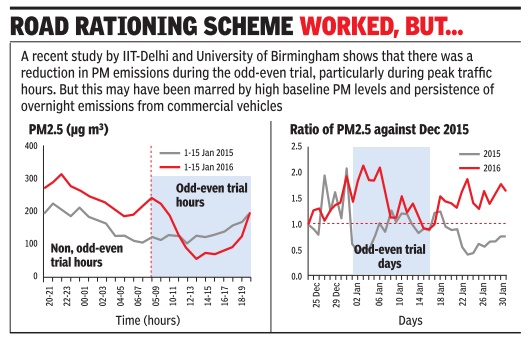
IIT Study Says Government Should Go For Staggered Timings If There's Another Round
A study on Delhi's odd-even trial has suggested that the road rationing scheme did improve air quality during the trial hours -especially during peak traffic hours -but those gains were lost due to heavy car and truck traffic during the nontrial hours between 8pm and 8am.
In addition to emissions from commercial vehicles, increased traffic at night after the odd-even hours may have led to the increase in the 24-hour average particulate matter (PM) values, reveals the study by IIT Delhi in collaboration with University of Surrey , University of Birmingham and others. It also found that the baseline concentrations --those excluding local emission sources such as vehicles estimated by IIT Delhi -at various locations were already high and masking the improvements from the odd-even trial.
The study used data from Delhi Pollution Control Committee (DPCC) to make their assessments for Anand Vihar, Mandir Marg, RK Puram and Punjabi Bagh. Except for RK Puram, all are near heavy traffic zones. It considered hourly averages for the oddeven days in January and April 2016 and the PM data for the same dates in 2015.
Researchers also found that meteorological factors like wind speed and direction played an important role. So while overall PM levels may have been higher during the odd-even phase in 2016 compared to same dates in 2015, it doesn't mean that the scheme failed to make a difference.“Observations clearly indicate that the comparison of the trial periods... will be affected by different background concentrations. Therefore as a necessary step, we estimated the baseline (local site background) concentrations at our selected sites.“
Baseline PM concentrations at all of these locations are taken and subtracted from the actual hourly concentrations to arrive at the net concentrations that can be attributed to vehicles. The team found there was a reduction in both net PM2.5 and PM10 concentrations during January and April trial hours but concentrations were much higher during the morning hours of odd-even and non-odd-even hours. “This seems likely to be related to the time taken for dispersion of the pollutants emitted overnight. The effect of the oddeven hours during winter ranged from a minimal re duction of -2% to a maximum reduction of -44% during peak traffic hours across the studied sites. This effect was relatively larger during summer with the corresponding reduction of -2% to -74% for PM2.5 compared to the 2015 levels.“
Professor Mukesh Khare of IIT Delhi, co-author of the study , said, “If the government is considering implementing the scheme again, they should consider staggered timings so that there is no sudden jump in emissions.“
“The real gains can only be achieved by restricting the entry of heavy goods vehicles during night hours,“ said the study , adding that commercial vehicles contribute to nearly half of the PM10 emissions from the exhaust of on-road vehicles in Delhi.
This is the first study to have singled out vehicular emissions to assess the impact of odd-even. Based on data assessment of previous years, scientists arrived at a baseline for each of these stations. The baseline PM2.5 was found to be the lowest and the highest at 12 and 113 micrograms per cubic metres at RK Puram and Anand Vihar, respectively .
Before another round, measures should be taken to “enable either full source apportionment of the particulate matter, or as a minimum, measurement of chemical tracers for road traffic emissions“, the study concluded.
See also
Air pollution: Delhi




